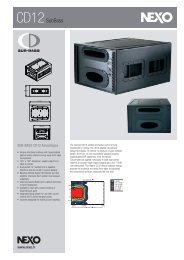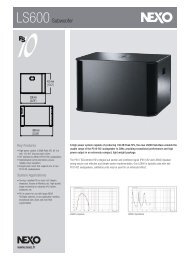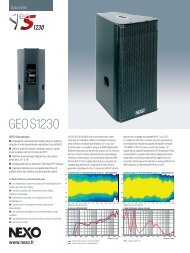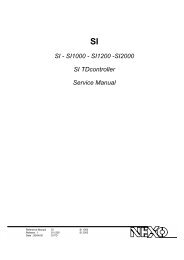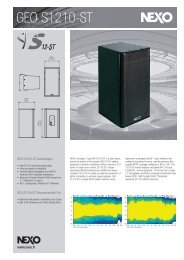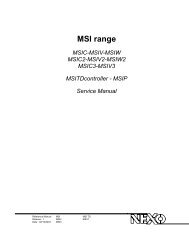NXAMP4x1 & NXAMP4x4 User Manual - Nexo
NXAMP4x1 & NXAMP4x4 User Manual - Nexo
NXAMP4x1 & NXAMP4x4 User Manual - Nexo
- No tags were found...
Create successful ePaper yourself
Turn your PDF publications into a flip-book with our unique Google optimized e-Paper software.
GENERAL DESCRIPTIONYou can see with the gray line on the above drawing that unused pins on outputspeakon are shorted together, but are not connected to ground. Therefore be careful asvery high voltage might be present on these unused pins.<strong>User</strong> interface blockThe user interface block has already been described through the front panel description inthe first part of this document. Please note that all the commands and displays areavailable through the ESmonitor software by Auvitran, through the Ethersound network(except the mains switch).Communication blockThe communication block regroups the RS232 port (on a sub-D9 plug) and the GPIO port(on a sub-D25 plug).The RS232 port is mainly used to upgrade the firmware of the unit from a PC computer.But it could also be used in the future for local communication with other equipments. Thepin-out is given bellow:The RxD pin is the “Receive data” pin from the NXAMP point of view. Thus this is an input.The TxD pin is the “Transmit data” pin from the NXAMP point of view. Thus this is anoutput. GND is the ground.A crossover cable (connecting RxD pin of NXAMP to TxD pin of computer, and so on) isneeded to use this serial port. Please see further the dedicated part of this document onthat subject.The GPIO port is a Global Purpose Input/Output signals system that can be use for a widerange of application, mainly interfacing the NXAMP with security systems. There are thefollowing signals available:• 8 x General purpose output signals from NXAMP (5 Volts signals)• 5 x General purpose input signals to NXAMP (5 Volts signals)• 4 x 5 Volts outputs• 8 x GND (ground) signals.The pin out of these signals is given bellow:PAGE 30 OF 103







